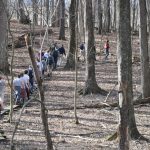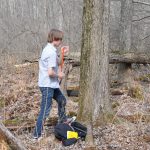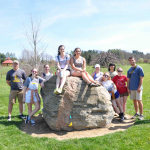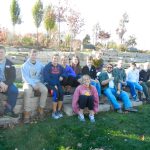Our class trudged up the staircase with no railings, to a level with gaps in the floorboards here and there. A few of us ventured on a wobbly ladder all the way upstairs into the attic. Who knows how old this place is?
We now have a better idea. To date the house’s timber—we cored seven beams, using a drill and manual coring. Dr. Wiles sawed a block from one beam. We took these samples back to the lab and sanded away.
Here’s where Alex, Lauren, and I—the Sloane House group—come in. Peering under microscopes, we counted the number of rings each sample had. Our data on this ranged from about 50 to over 100. We measured the cores multiple times, under microscopes, with a program that recorded how far the sample moved. We counted from the year 1000. Sometimes, the lighter early wood and the darker late wood blurred together. Sometimes, the rings zigzagged and were not parallel. Sometimes, our measurements did not correlate.
We used the computer program COFECHA to crossdate the samples against each other and to develop a “floating” site chronology, which we calendar dated. This chronology was then crossdated with trees from The College of Wooster campus (thank you to that group) and the Northeastern Ohio database.
So when do we think the house was built?

Two of our samples have bark (SH02 and SH03), which means they show outer rings and the latest date the timber was cut. The calculated date for is 1851 for SH02 and 1852 for SH03. Our other dates are listed in the table below. What could this mean?
| Core | Inner Year | Outer Year | Total Years |
| SH01 |
1784 |
1849 |
66 |
| SH02 |
1797 |
1851* |
55 |
| SH03 |
1774 |
1852* |
79 |
| SH04 |
1763 |
1849 |
87 |
| SH05 |
1793 |
1852 |
60 |
| SH06 |
1749 |
1852 |
104 |
| SH07 |
Taken out |
||
| SH08 |
1727 |
1839 |
113 |






